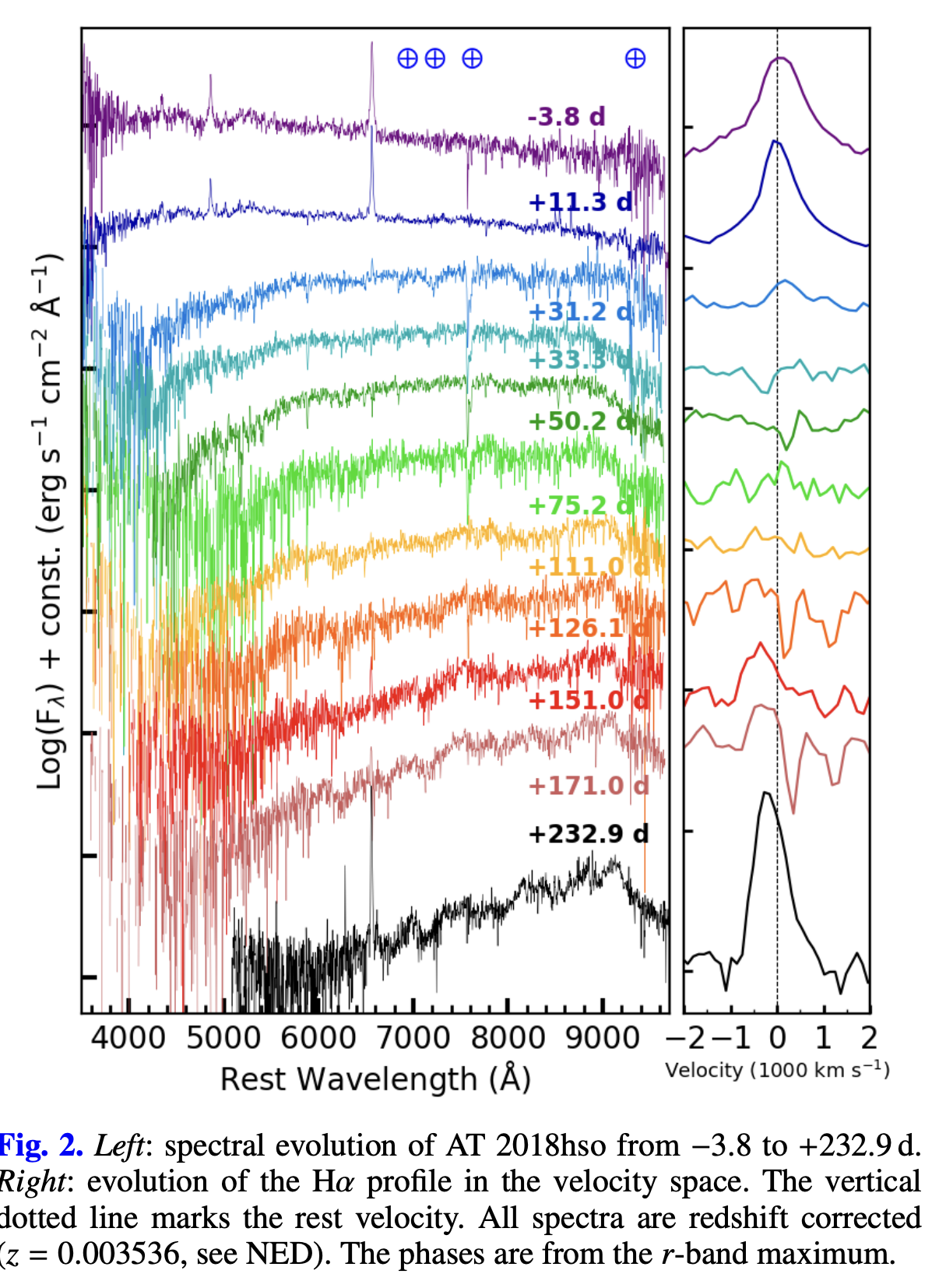Padova-Asiago Supernova Group
Highlights
The transitional gap transient AT 2018hso: new insights into the luminous red nova phenomenon
Cai, Y. Z. et al. 2019 Astro Astrophys 632, 6 (link to pdf)
Context. The absolute magnitudes of luminous red novae (LRNe) are intermediate between those of novae and supernovae (SNe), and show a relatively homogeneous spectro-photometric evolution. Although they were thought to derive from core instabilities in single stars, there is growing support for the idea that they are triggered by binary interaction that possibly ends with the merging of the two stars. Aims: AT 2018hso is a new transient showing transitional properties between those of LRNe and the class of intermediate-luminosity red transients (ILRTs) similar to SN 2008S. Through the detailed analysis of the observed parameters, our study supports that it actually belongs to the LRN class and was likely produced by the coalescence of two massive stars. Methods: We obtained ten months of optical and near-infrared photometric monitoring, and 11 epochs of low-resolution optical spectroscopy of AT 2018hso. We compared its observed properties with those of other ILRTs and LRNe. We also inspected the archival Hubble Space Telescope (HST) images obtained about 15 years ago to constrain the progenitor properties. Results: The light curves of AT 2018hso show a first sharp peak (reddening-corrected Mr = -13.93 mag), followed by a broader and shallower second peak that resembles a plateau in the optical bands. The spectra dramatically change with time. Early-time spectra show prominent Balmer emission lines and a weak [Ca II] doublet, which is usually observed in ILRTs. However, the strong decrease in the continuum temperature, the appearance of narrow metal absorption lines, the great change in the Halpha strength and profile, and the emergence of molecular bands support an LRN classification. The possible detection of a MI ~ -8 mag source at the position of AT 2018hso in HST archive images is consistent with expectations for a pre-merger massive binary, similar to the precursor of the 2015 LRN in M101. Conclusions: We provide reasonable arguments to support an LRN classification for AT 2018hso. This study reveals growing heterogeneity in the observables of LRNe than has been thought previously, which is a challenge for distinguishing between LRNe and ILRTs. This suggests that the entire evolution of gap transients needs to be monitored to avoid misclassifications. The light curves and the reduced spectra are only available at the CDS via anonymous ftp to http://cdsarc.u-strasbg.fr (ftp://130.79.128.5) or via http://cdsarc.u-strasbg.fr/viz-bin/cat/J/A+A/632/L6 211
Cai, Y. Z. et al. 2019 Astro Astrophys 632, 6 (link to pdf)
Context. The absolute magnitudes of luminous red novae (LRNe) are intermediate between those of novae and supernovae (SNe), and show a relatively homogeneous spectro-photometric evolution. Although they were thought to derive from core instabilities in single stars, there is growing support for the idea that they are triggered by binary interaction that possibly ends with the merging of the two stars. Aims: AT 2018hso is a new transient showing transitional properties between those of LRNe and the class of intermediate-luminosity red transients (ILRTs) similar to SN 2008S. Through the detailed analysis of the observed parameters, our study supports that it actually belongs to the LRN class and was likely produced by the coalescence of two massive stars. Methods: We obtained ten months of optical and near-infrared photometric monitoring, and 11 epochs of low-resolution optical spectroscopy of AT 2018hso. We compared its observed properties with those of other ILRTs and LRNe. We also inspected the archival Hubble Space Telescope (HST) images obtained about 15 years ago to constrain the progenitor properties. Results: The light curves of AT 2018hso show a first sharp peak (reddening-corrected Mr = -13.93 mag), followed by a broader and shallower second peak that resembles a plateau in the optical bands. The spectra dramatically change with time. Early-time spectra show prominent Balmer emission lines and a weak [Ca II] doublet, which is usually observed in ILRTs. However, the strong decrease in the continuum temperature, the appearance of narrow metal absorption lines, the great change in the Halpha strength and profile, and the emergence of molecular bands support an LRN classification. The possible detection of a MI ~ -8 mag source at the position of AT 2018hso in HST archive images is consistent with expectations for a pre-merger massive binary, similar to the precursor of the 2015 LRN in M101. Conclusions: We provide reasonable arguments to support an LRN classification for AT 2018hso. This study reveals growing heterogeneity in the observables of LRNe than has been thought previously, which is a challenge for distinguishing between LRNe and ILRTs. This suggests that the entire evolution of gap transients needs to be monitored to avoid misclassifications. The light curves and the reduced spectra are only available at the CDS via anonymous ftp to http://cdsarc.u-strasbg.fr (ftp://130.79.128.5) or via http://cdsarc.u-strasbg.fr/viz-bin/cat/J/A+A/632/L6 211
